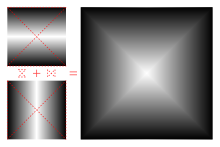

Mach bands is an optical illusion named after the physicist Ernst Mach. It exaggerates the contrast between edges of the slightly differing shades of gray, as soon as they contact one another, by triggering edge-detection in the human visual system.
YouTube Encyclopedic
-
1/3Views:1 9559 1011 474 010
-
Mach's Principle the paradox of mass there influences inertia here
-
Lateral Inhibition | Psychology | Chegg Tutors
-
The Coriolis Effect
Transcription
Explanation
The Mach bands effect is due to the spatial high-boost filtering performed by the human visual system on the luminance channel of the image captured by the retina. Mach reported the effect in 1865, conjecturing that filtering is performed in the retina itself, by lateral inhibition among its neurons.[1] This conjecture is supported by observations on other (non-visual) senses, as pointed out by von Békésy.[2] The visual pattern is often found on curved surfaces subject to a particular, naturally-occurring illumination, so the occurrence of filtering can be explained as the result of learnt image statistics. The effect of filtering can be modeled as a convolution between a trapezoidal function that describes the illumination and one or more bandpass filters. A tight approximation is obtained by a model employing 9 even-symmetric filters scaled at octave intervals.[3]
The effect is independent of the orientation of the boundary.
In radiology

This visual phenomenon is important to keep in mind when evaluating dental radiographs for evidence of decay, in which grayscale images of teeth and bone are analyzed for abnormal variances of density. A false-positive radiological diagnosis of dental caries can easily arise if the practitioner does not take into account the likelihood of this illusion. Mach bands manifest adjacent to metal restorations or appliances[citation needed] and the boundary between enamel and dentin.[5] Mach bands may also result in the misdiagnosis of horizontal root fractures because of the differing radiographic intensities of tooth and bone.[6]
Mach effect can also lead to an erroneous diagnosis of pneumothorax by creating a dark line at the lung periphery (whereas a true pneumothorax will have a white pleural line).[7]
In computer graphics

- Actual luminance profile
- Perceived luminance profile
- Smooth luminance profile for comparison
Mach bands can also appear when there is a discontinuity in the derivative of a gradient, a visual effect common when intensities are linearly interpolated such as in Gouraud shading.
Computer image processing systems use edge-detection in a way analogous to the brain, using unsharp masking to clarify edges in photos for example.
See also
- Acutance
- Cornsweet illusion
- Hermann grid illusion
- Lateral inhibition
- Optical illusions
- Watercolour illusion
- Gibbs phenomenon
References
- ^ Ratliff, Floyd (1965). Mach bands: quantitative studies on neural networks in the retina. Holden-Day. ISBN 9780816270453.
- ^ von Békésy, Georg (1967). "Mach Band Type Lateral Inhibition in Different Sense Organs" (PDF).
- ^ Frederick A. A. Kingdom (4 November 2014). "Mach bands explained by response normalization". Frontiers in Human Neuroscience. 8: 843. doi:10.3389/fnhum.2014.00843. ISSN 1662-5161. PMC 4219435. PMID 25408643.
- ^ P. Ambalathankandy et al, Radiography Contrast Enhancement: Smoothed LHE Filter a Practical Solution for Digital X-Rays with Mach Band, 2019 Digital Image Computing: Techniques and Applications
- ^ Devlin, Hugh. Operative Dentistry: A Practical Guide to Recent Innovations, Springer 2006 ISBN 978-3-540-29616-4 page 11
- ^ Nielsen, Christen J.; "Effect of Scenario and Experience on Interpretation of Mach Bands," Journal of endodontics Volume 27, Issue 11, Pages 687–691
- ^ Parker, M. S.; Chasen, M. H.; Paul, N. (2009). "Radiologic Signs in Thoracic Imaging: Case-Based Review and Self-Assessment Module". American Journal of Roentgenology. 192 (3_Supplement): S34-48. doi:10.2214/AJR.07.7081. PMID 19234288. S2CID 34785665.
Further reading
- Lotto RB, Williams SM, Purves D (1999). "Mach bands as empirically derived associations". Proceedings of the National Academy of Sciences. 96 (9): 5245–50. Bibcode:1999PNAS...96.5245L. doi:10.1073/pnas.96.9.5245. PMC 21849. PMID 10220451.
- Eagleman, DM (2001) "Visual Illusions and Neurobiology." Nature Reviews Neuroscience. 2(12): 920–6.
External links
- Demonstration of the Mach band was at NIST until July 2016
- Mach Band figure and explanatory hypothesis, Laboratory of Dale Purves
